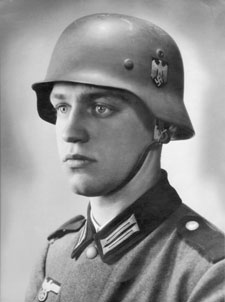|
Hitler's Jewish Soldiers
By Jerry Klinger
"The Ideal German Soldier"
"In hardly any people in the world is
the instinct of self-preservation developed more strongly
than in the so called "chosen."…What people,
finally, has gone through greater upheavals than this one – and
nevertheless issued from the mightiest catastrophes of mankind
unchanged? What an infinitely tough will to live and preserve the
species from these facts."
Adolf
Hitler
– Mein Kampf
In 1940, Unteroffizier Dieter Bergmann wrote to his Jewish grandmother, Elly Landesberg nee Moackrauer:
"Don’t
you realize how much I’m with my whole being rooted in Germany.
My life would be very sad without my homeland, without the wonderful
German art, without the belief in Germany’s powerful past and
the powerful future that awaits Germany. Do you think that I can
tear that all out of my heart?...Don’t I also have an
obligation to my parents, to my brother who showed his love to our
Fatherland by dying a hero’s death on the battlefield….Someday,
I want to be a German amongst Germans and no longer a second-class
citizen only because my wonderful mother is Jewish."
"Under
traditional Jewish law, a child born to a Jewish mother, no matter
whom the father may have been, is Jewish…. I am confused….
Who is a Jew? What is a Jew? When are you a Jew? What if you do not
want to be a Jew? Can we choose?"
William
Rabinowitz
"The
Nuremberg
Laws or
Nurnberg
Laws
(German:
Nürnberger
Gesetze)
of 1935 were anti-Semitic
laws
in Nazi
Germany
introduced at the annual Nuremberg
Rally
of the Nazi
Party.
After the takeover
of power in 1933
by Hitler,
Nazism
became an official ideology
incorporating scientific
racism
and anti-Semitism.
There was a rapid growth in German legislation directed at Jews,
such as the Law
for the Restoration of the Professional Civil Service
which banned "non-Aryans" from the civil-service."
The Nuremberg Laws, as they became known, did not define a "Jew"
as someone with particular religious beliefs. Instead, anyone who had
three or four Jewish grandparents was defined as a Jew, regardless of
whether that individual identified himself or herself as a Jew or
belonged to the Jewish religious community. Many Germans who had not
practiced Judaism for years found themselves caught in the grip of
Nazi terror. Even people with Jewish grandparents who had converted
to Christianity were defined as Jews."
The lack of a clear legal method of defining
who was Jewish
had, however, allowed some Jews to escape some forms of
discrimination aimed at them. The enactment of laws identifying who
was Jewish made it easier for the Nazis to enforce legislation
restricting the basic rights of German Jews….
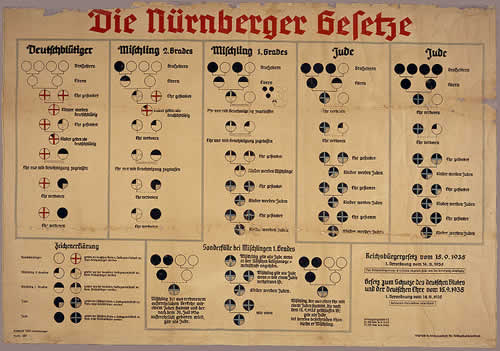
Nurmberg Law – 1935 Racial Chart
"The
Laws for the Protection of German Blood and German Honor
(September 15, 1935) Moved by the understanding that
the purity of German blood is essential to the further existence of
the German people, and inspired by the uncompromising determination
to safeguard the future of the German nation, the Reichstag has
unanimously resolved upon the following law, which is promulgated
herewith:
Section 1
Marriages
between Jews and citizens (German:
Staatsangehörige)
of German or kindred blood are forbidden. Marriages concluded in
defiance of this law are void, even if, for the purpose of evading
this law, they were concluded abroad.
Proceedings for annulment may be initiated only by
the Public
Prosecutor.
Section 2
Extramarital
sexual intercourse between Jews and subjects of the state of Germany
or related blood is forbidden.
Section 3
Jews will not be permitted to employ female citizens
under the age of 45, of German or kindred blood, as domestic
workers.
Section 4
Jews are forbidden to display the Reich
and national
flag or the national
colors.
On the other hand they are permitted to display the
Jewish colors. The exercise of this right is protected by the State.
Section 5
A person who acts contrary to the prohibition of
Section 1 will be punished with hard
labor.
A person who acts contrary to the prohibition of
Section 2 will be punished with imprisonment
or with hard labor.
A person who acts contrary to the provisions of
Sections 3 or 4 will be punished with imprisonment up to a year and
with a fine,
or with one of these penalties.
Section 6
The Reich Minister of the Interior in agreement with
the Deputy Fuehrer and the Reich Minister
of Justice will issue the legal and administrative regulations
required for the enforcement and supplementing of this law.
Section 7
The law will become effective on the day after its
promulgation; Section 3, however, not until January 1, 1936.
The
Nurmberg Laws, intended to define who is a Jew and who is an Aryan,
were deeply flawed. They were flawed, not just because of the
"racial" separation they were intended to create between
the Jew and the non-Jew, but because they failed to make clear what
to do with the Mischlings.
"The
word Mischling means ‘half-caste, mongrel or hybrid’….The
term was first applied to people with one black and one white parent
in Germany’s African colonies. Some Germans at the time called
these children the ‘Rehoboth bastards.’ In the 1920’s,
when French colonial soldiers had affairs with women in German
territories they occupied, the children who resulted were called
Mischling. Hitler believed that the Jews brought these French Blacks
to Germany to destroy the ‘White Race.’
…In
1935, the Nuremberg Laws created two new "racial"
categories: the half-Jew (Jewish Mischling first degree), and the
quarter –Jew (Jewish Mischling second degree). A half-Jew had
two Jewish grandparents; a quarter –Jew had one. Since Nazi
racial policy declared anyone of the Jewish religion a full Jew
regardless of ancestry, most were by definition Christians."
…After
the advent of Nazi rule in 1933, the process of assimilation came to
a halt, but the results of that assimilation, namely Mischlings,
confounded many Nazis.
Nazis
were confused about Mischlings, since they were both Jewish and
German. Adolf Eichmann, SS-Obersturmbannfueher and chief of the
Jewish Evacuation Office of the Gestapo, acknowledged that the
unclear racial position of Mischling temporarily protected them. For
the Nazis, Mischling were also half or three-quarters German, and
thus 50 percent or 75 percent valuable."
The
confused status of the Mischling resulted in confused responses.
Werner Eisner, a half-Jew and severely wounded Wehrmacht veteran was
deported to Auschwitz for sleeping with an Aryan. Dr. Hans Serelman,
a German Jew, was also sent to a concentration camp. His crime, he
donated his own blood to save a non-Jewish patient.
In
practice Mischlings German citizenship was stripped away. They were
denied access to certain universities for advanced degrees including
medicine and law. They were denied access to recreational facilities
and civilian jobs. Mischlings were denied positions of authority
over Aryans. They were excluded from some churches, even though they
were baptized Christians. They were socially ostracized.
"The
Evangelische Landeskirche
officially announced that "racially Jewish Christians have no
place and no rights’ as members in the Protestant Church."
Being
50% Jewish, or only 25% Jewish, did not protect the Mischlings.
Growing "racial" restrictions on Mischlings slowly
constructed a bleak future. The sudden grouping of the Mischling with
the Jew logically should have created a common link of sympathy and
mutual support between the Mischling and the Jew. It did not.
Most
Mischlings did not identify with the Jewish community. Many had
grown up as baptized Christians and even were themselves very
anti-Semitic. They preferred to think of themselves as normal, as
part of the whole of German fabric, as part of the "Volk".
Their language, their culture, the societal relationships and
schooling all had been German. Even for those who grew up knowing
that they had had a parent who was Jewish, they preferred not be left
behind and identified as Jewish. They yearned, worked and did
everything within their capabilities to prove themselves as good,
loyal members of the Germanic peoples. They needed to show the
German world that their German blood was the dominant force that
flowed in their veins.
On
the other hand, the pure Germans without the taint of Jewish blood,
kept a closer eye on the Mischling. They kept an eye
to see if any of the corrupting
influence of Jewish blood showed itself.
Historically,
one of the ways for Jews to prove themselves more German than Jewish
was to fight for the "Fatherland".
Many
Jews had served in the German and Austrian armies during World War I.
Tens of thousands had died in that conflict, laying down their lives
for the Kaiser and the Emperor. A large number of Jews rose to
officer ranks, especially in the Austrian army. Thousands of Jews,
in both armies, were decorated for bravery with the highest honors.
Service in the armed forces, during World War I, had been a way for
the Jew to gain access to greater acceptance, opportunity and to
prove their loyalty to everything Germanic.
As
the Nazi political and war machine rumbled into life and rearmament,
only fifteen years after the end of World War I, existence for the
Jew and the Mischling became more threatening, more tenuous. For the
full Jew, little could be done in the "racist" mania of
authoritarian Germany. The Mischling faced a paradox. "During
the war, many felt torn between the desire to belong, regain some of
their lost pride, and protect themselves and their families through
military service and the realization that to do so, they had to serve
Hitler…

Half-Jew
Horst Geitner
Wehrmacht
service, in the early years of the war, protected them from the
Gestapo. Ilse Korner wrote of her deceased husband, half-Jew and
Lieutenant Hans Joachim Korner, ‘He wanted to distinguish
himself through his bravery and willingness to fight as a soldier and
thus, escape the persecution of the Nazis’……
their sense of pride made them seek every opportunity to be like
everyone else.
Most
believed their meritorious service would convince their comrades and
society to accept them as "normal."
Mischlings disproportionally risked their lives on the battlefield
to prove themselves to their comrades, officers and Nazi masters.
Many were decorated with Nazi Germany’s highest military
honors, including 20 who received the Ritterkreuz.
Wehrmacht
soldier Helmut Kruger’s mother was Jewish. "He did all he
could to prove his loyalty to Germany by showing his bravery in
battle. He won the EKII, the EKI, and the Golden Wound Badge. His
brother, Reinhardt, claimed that he was brave soldier only because he
was a Mischling fearing to be called a "cowardly Jew (feiger
Jude)’.
The
ironic paradox; ‘Kruger stated that if it was not for his
Jewish mother he would have joined the Party and the SS."
Mischling
status greatly restricted upward mobility in German society and in
the army. Mischlings, with the cooperation of their families, sought
to change the official classification of who they were. They wanted
to be recognized as Germans. One of the methods was to obtain legal
waivers,
Genehmigungs,
granted by German officialdom – a toleration of their Mischling
status because of their particular service and benefit to the Reich.
The most sought after legal solution to Mischling disqualifications
was for a legal review and determination of pure blood, racially
untainted with Jewish blood, the Deutschblutigkietserkarung.
Hermann
Goering had said it was he who decided who was a Jew or not. The
reality, the decision as to who ultimately was a Jew could only be
granted by Adolf Hitler. Hitler reviewed each situation personally.
With the Deutschblutigkietserkarung , formerly classified Mischlings
were cleared of any Jewish taint. They could and did advance to high
administrative and military positions.
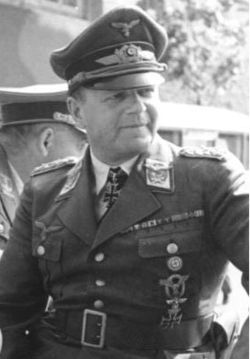
Half –Jew Field Marshall Erhard Milch
"In
1933 Frau Clara Milch went to her son-in-law, Fritz Heinrich Hermann,
police president of Hagen and later S.S. general, and gave him an
affidavit stating that her deceased uncle, Carl Brauer, rather than
her Jewish husband Anton Milch, had fathered her six children. After
SA Colonel Theo Croneiss denounced (Erhard) Milch
to Goering, Goering took Milch’s mother’s affidavit to
Hitler. In 1935, Hitler accepted the mother’s testimony and
instructed Goering to have Dr. Kurt Meyer, head of the Reich Office
for Genealogy Research, complete the paperwork. On 7 August 1935,
Goering wrote Meyer to change Milch’s father in his documents
and issue him papers certifying his pure Aryan descent. After the
war, according to one Goering’s interrogators, John E.
Dolibois, Goering was proud of his action to help half Jew Milch
remain in Luftwaffe…. Milch became a Field Marshall who ran
the Luftwaffe – in charge of planning, production and strategy.
Milch’s
daughter was married to an SS General."
A
large number of former Mischlings rose to high rank: 2 Field
Marshals, 15 Generals, 2 full Generals, 8 Lieutenant Generals, and 5
Major Generals. Former Mischling were Nazi party members – 4
were full Jews, 15 were half Jews and 7 were quarter Jews.
 |
 |
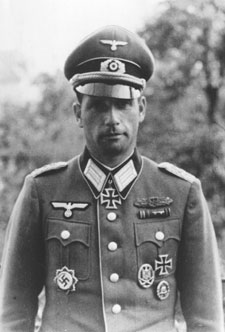 |
| Half-Jew General Helmut Wilberg |
Half –Jew General Johannes Zuckertort |
Half-Jew Col. Walter H. Hoellander |
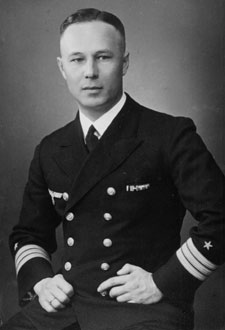 |
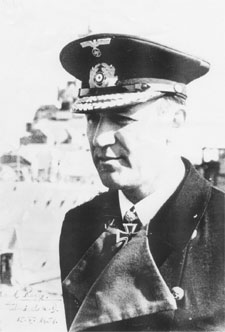 |
| Half-Jew Commander Paul Ascher |
Quarter- Jew Admiral Bernhard Rogge
1st Officer on the Bismar |
Of
the estimated 150,000 Mischlings, half Jews and quarter Jews, in the
Nazi armies, most never rose to officer levels.
Wehrmacht
soldier Joachim Lowen told his story. "My own brother (Heinz)
went to the Gestapo and claimed that our mother was a slut and had
been a prostitute. The Gestapo reviewed our case and declared us
Deutschblutig (of German blood)." Mother was destroyed –
Heinz died on the Russian front, he was a oberscharfuher of the
Waffen SS."
Yet
some Mischlings and their families refused to abandon their own but
were abandoned by the Jewish world. Of the many ironies of life in
pre-Nazi and during the 12 years of Nazi Germany’s existence,
Jewish attitudes towards the Mischling were equally confused. Bryan
Mark Rigg, the noted historian, in his book, Hitler’s
Children,
interviewed 1,671 Mischlings. 60% were Halachicly Jewish. He
commented about those who had Jewish self identification:
"Half-Jews
with Jewish fathers were more likely to feel a connection with
Judaism than those with Jewish mothers, who by Halakah were Jews.
This fact shows that Halacha in many respects was out of step with
social reality – namely, that a father’s religious
convictions influenced a child’s upbringing more than the
mother’s did. Perhaps this was because of the generally
patriarchal nature of most German households. This corroborated by
the fact that most in this study who were circumcised had Jewish
fathers. "
Jewish
traditional values frowned on intermarriage.
"Helmuth
Kopp remembered how, on the few occasions he saw him during the
1920’s and early 1930’s, his Jewish grandfather, Louis
Kaulbars, hit him with a whip and called him goy. Although he had a
Jewish mother, his grandfather did not consider him Jewish. One day
his grandmother protested this treatment, telling her husband,
"That’s our daughter Helen’s child!" The
grandfather replied, "No that’s Wilhelm’s goy!"
My soul was damaged, Kopp said in 1995. Mother died in 1925, he
went to live with his Jewish aunt and uncle. He attended orthodox
school, and had a belated bris. He entered the Wehrmacht in 1941."
As
resources to aide Jews within Germany became strained, Jewish
responses became twisted as well.
"When
the youthful Hannah Klewansky went ot the Gestapo office on the
November morning after Reichskristallnacht. In 1938, to inquire
where the Nazis had taken her Jewish father Eugen, a sign informed
her that the Jewish Community Center was processing such inquiries.
She went there and waited in a long line of anxious people looking
for loved ones. When her turn arrived, the Jewish secretary got out
her family’s file. "Is your father Christian?"
Hannah answered that yes he was a converted Jew. Then the official
asked if she was Jewish. She answered that her mother was not Jewish
and that she herself had been raised Christian. The secretary then
sent Hannah away saying, "We don’t deal with your kind."
Hannah then boldly returned to the Gestapo to ask how she could
locate her father. The officer took her to a back room where two SS
men were playing cards. The officer asked the men if they like what
they saw and left. "They raped her."
Fortunately
for the Mischlings, the war ended with Germany’s defeat.
Hitler had planned to exterminate them, completely cleansing the
German
blood line
after German victory. The surviving Mischlings returned home. They
all, like the general population of Germany and Europe, claimed to
have known nothing of the Holocaust. Many of the Mischlings were
aware of rumors and stories. They had to know something as their own
families were exterminated. Uniformly, they chose to know or
acknowledge nothing. None admitted to being involved in atrocities
against Jews. None admitted to being involved in atrocities but some
of the highest ranking Mischlings were very aware of the murders and
even administratively aided the logistics of the processes.
For
Mischlings, the return home was as confused and difficult as it had
been to be part of the Nazi story itself.
"After
the war Mischlings tried to learn about their Jewish ancestry. (Some
fought for Israel in the War of Independence.) Some converted, many
visited Israel, Half-Jew Werner Eisner’s son Mijail (Michael)
not only immigrated to Israel but also served in the Israeli army.
He must have converted, since his mother was not only not Jewish, but
was a daughter of an S.S. man."
Mischling
Hanns Rehfeld told Riggs:
"I
have been discriminated against in my life for three things I could
do nothing about. First, my Jewish relatives discriminated against
me because I had a Christian mother (Schickse). Secondly, the
Germans discriminated against me because I had a Jewish father. And
(after the war), when I worked in the foreign service for many years,
people discriminated against me because I was a German (i.e., I must
be a Nazi.). – His father died in a Gestapo prison."
"The
legacy and the Nazi thinking continued to cloud many Mischlings views
of Jews. Walter Schonewald "A Jew is only a religion;
everything else is Hitler; everything else is racism. "Schonewald
claimed that Israel has its own racial laws in that rabbinical courts
prevent marriages between Jews and non-Jews and do not recognize the
Reform or Conservative movements."
Riggs’
footnotes noted that some orthodox Jews had welcomed the Nazi
Nuremberg Laws as they prevented intermarriage and assimilation.
"Because
of their experiences with some religious Jews, many Mischling blame
Orthodox Jews for anti-Semitism. Quarter Jew Fritz Binder claimed
that Orthodox Jews, by maintaining they are the only ones with have
found the "truth" and that their "lifestyle is the
best, are just as bad as the Nazis." Half-Jew Bergmann said,
"The fact that the religious Jews pray each day and thank God
that He did not make them gentiles is disgusting." Quarter Jew
Horst von Oppenfeld, a descendant of the Jewish Oppenheim family, who
was a captain and an adjutant to Stauffenberg, said that Orthodox
Jews experience so many problems because they do not assimilate.
"Their problem" he claims "is due to the fact that
they want to be different. Consequently, many Mischling avoid
contact with very religious Jews."
Today,
"many Mischling, especially in Vienna, refused to meet, stating
that they had not discussed their past even with their own families
and saw no reason to do so…Some still fear that people will
reject them once they learn they are "partially" Jewish.
For example, Rolf Zelter, whose 75 percent Jewish father
Obergefreiter Joachim Zelter fought on the Russian front, found out
about his Jewish past after the war. When he confronted his mother,
she quickly told him, "Don’t let your children know. It
can only cause them problems." For the Zelters, like many
families documented in this study, Jewish ancestry should simply be
concealed and forgotten."
Contemporary
American Christian – Jewish intermarriage rates are near 50%.
There are an estimated 400,000+ children living in households of
mixed religious backgrounds. The numbers are estimated because, as
was explained by the director of a major Northeastern United States
Jewish Federation director, when asked how do you know how many Jews
are there in your State, he said "we guesstimate."
"What
do you mean – guesstimate?"
"If
a household joins Federation and says they are Jewish we assume that
both mother and father are Jewish."
"How
do you know?"
"We
don’t. We don’t ask."
The
problem of Jewish identity in Israel is extremely murky, especially
since 800,000 Russians immigrated in the 1990’s and 2000’s.
Many of the Russian immigrants to Israel came because of Israel’s
Right of Return Law. With little doubt many of the Russian
immigrants could not clearly and conclusively prove they were Jewish
– being born of a Jewish mother. Many arrived only knowing, or
claiming, that they had one grandparent that was Jewish. The
resultant "don’t ask, don’t tell" policy has
severely disrupted inter-Jewish relations in Israel. It has added
significantly to present and future tensions for Jewish marriage,
divorce and life cycle events such as death and burial which are
controlled by the Orthodox Rabbinate.
Though
the terrible tragedy happened more than ten years ago, the story
still resonates within Israel today.
The debate over
burials has gone on in Israel for years, picking up steam in the
early 1990s with the wave of Soviet immigration. The Israel Religion
Action Center estimates that 150,000 to 200,000 of the 700,000 new
arrivals are not technically Jewish.
In 1992, the Israeli
Supreme Court ruled that cemetery lands should be allotted for people
unwilling or unable to meet the requirements of the Orthodox burials.
A Knesset bill last year made a similar directive.
Nevertheless,
development of alternative cemeteries has been stalled by staunch
resistance from the Orthodox rabbinate.
"The religious
establishment is afraid that the stronghold of Orthodoxy will
dissipate rapidly if alternatives are offered,'' said Rabbi Regev of
the Religious Action Center. ``They want to control everything that
is Jewish.''
A
furor arose in 1993 over the burial of Lev Pisahov, an Israel army
corporal killed by Hamas terrorists at a checkpoint. Initially buried
outside a Jewish cemetery, his body was moved inside after then-Prime
Minister Yitzhak Rabin intervened. Last year, when a 19-month-old
killed in a car accident was about to be buried in the town of
Sderot, an Orthodox rabbi disrupted the funeral, demanding that the
grave be dug outside the cemetery because the boy's mother was not
Jewish."
* * * * *
Jerry Klinger is
president of the Jewish American Society for Historic Preservation
www.Jashp.org
email: Jashp1@msn.com

~~~~~~~
from the September 2011 Edition of the Jewish Magazine
|
